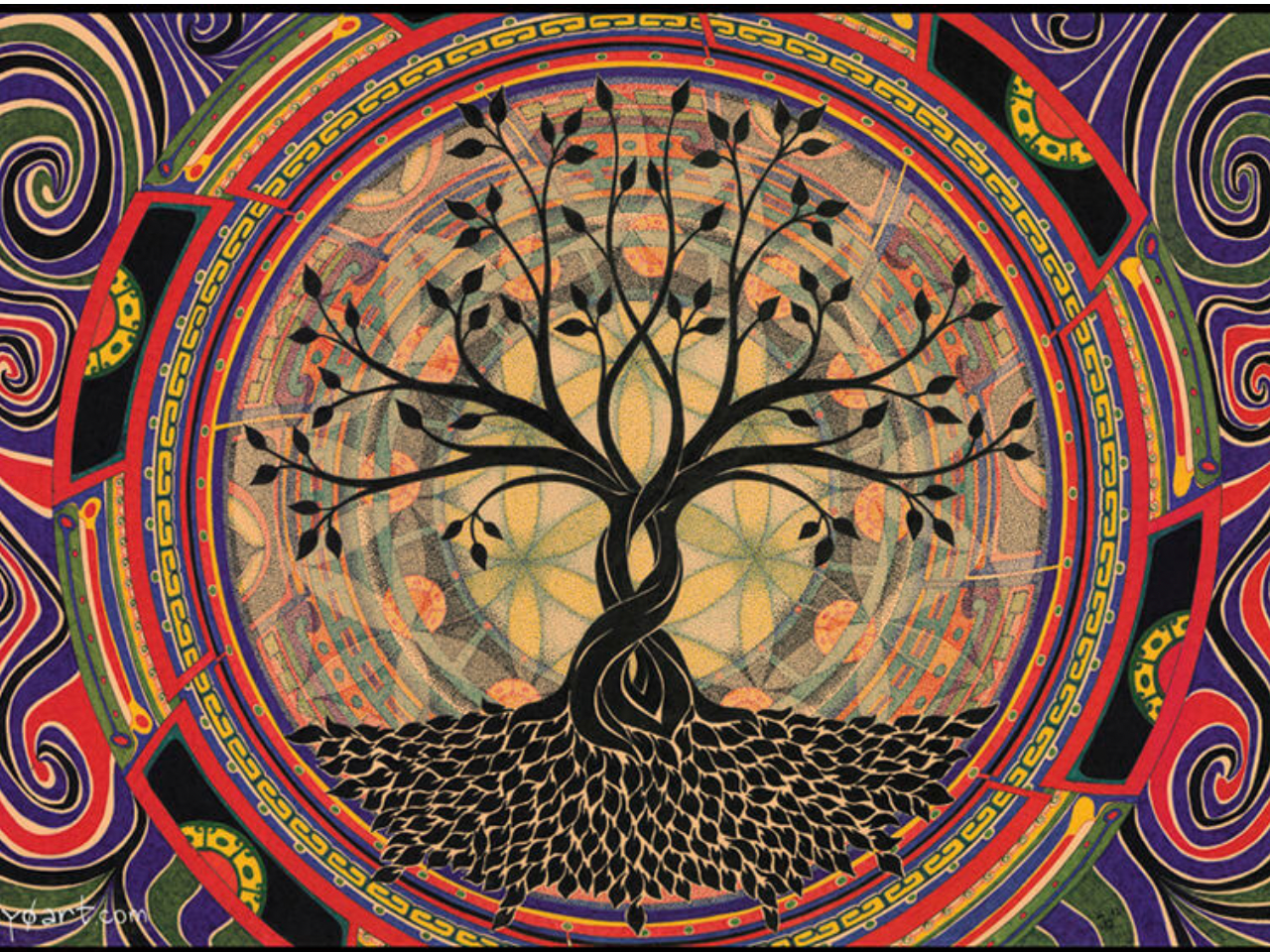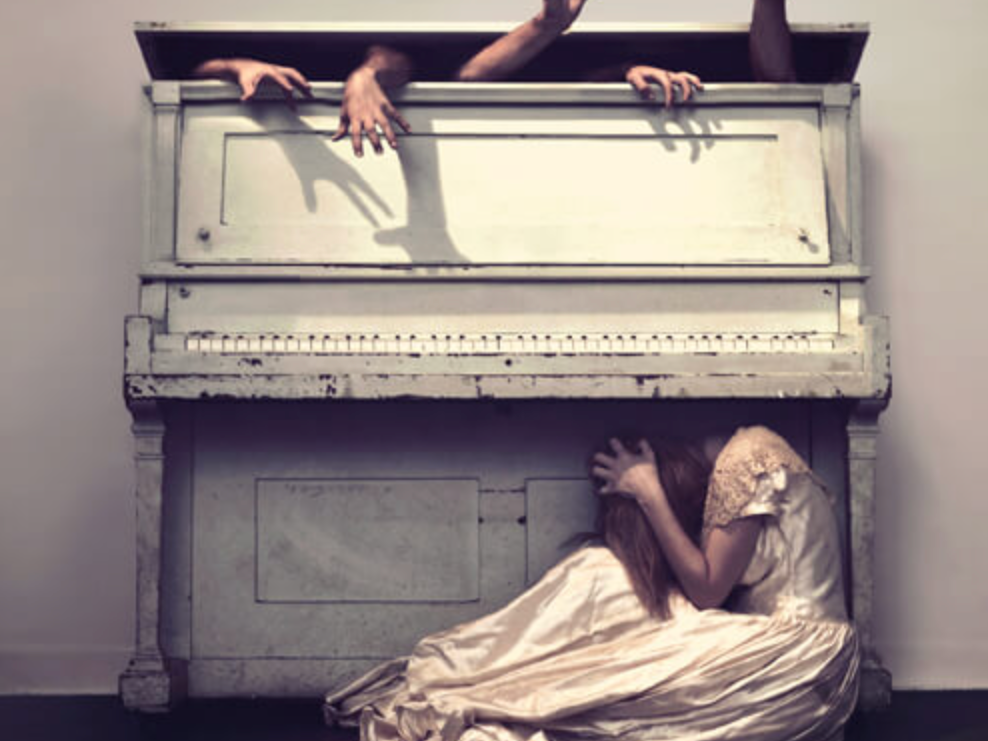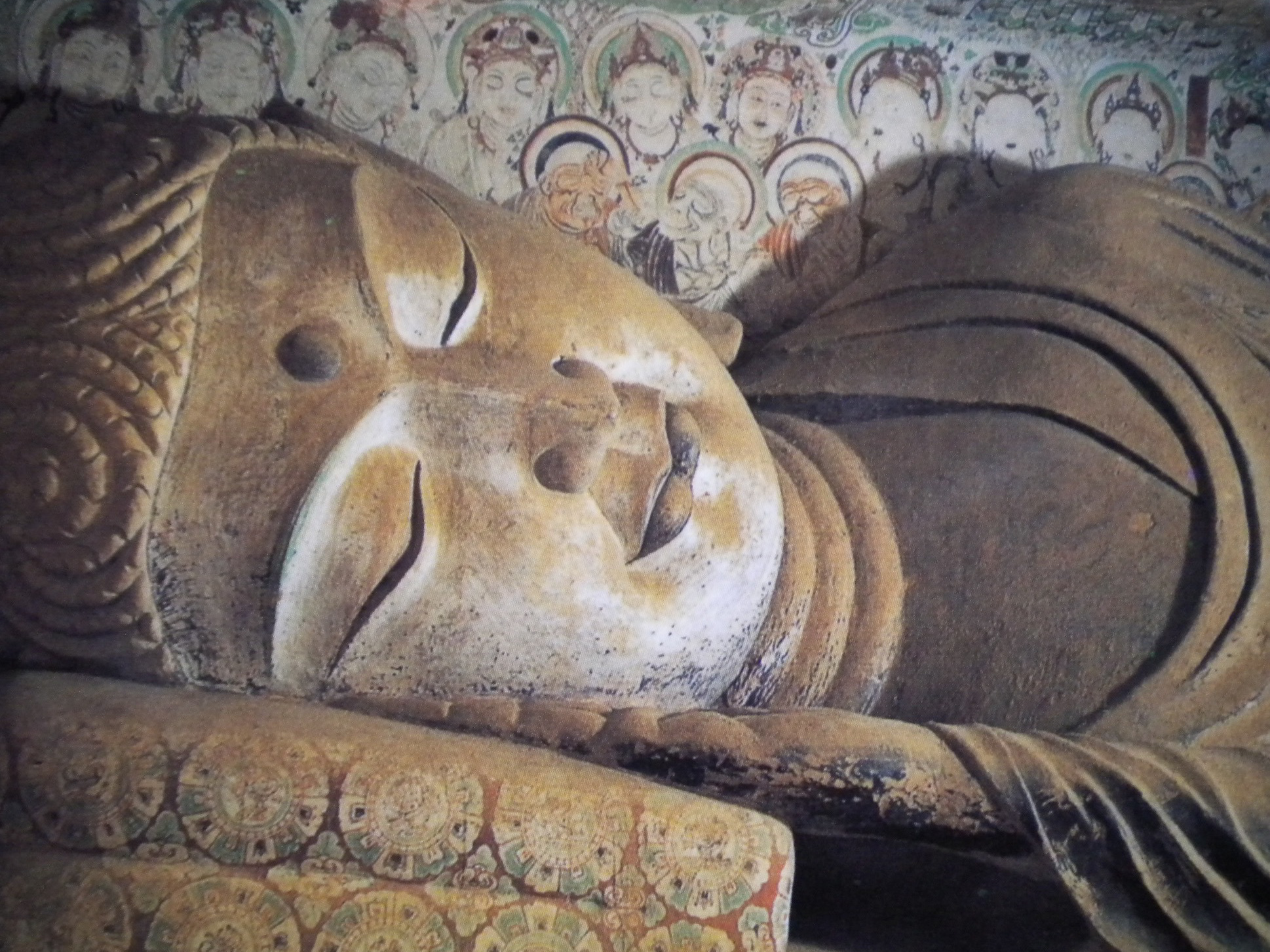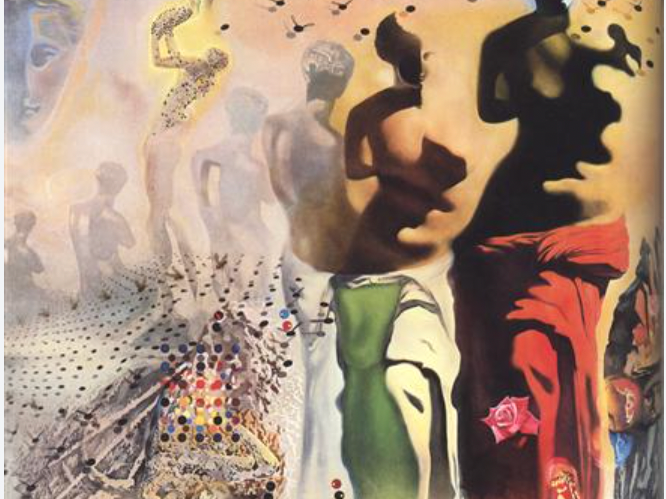A Knight’s Dream by Antonio de Pereda
“Deep inside us is a wilderness. We call it the unconscious because we can’t control it fully, so we can’t create what we want from it. The collective unconscious is a great wild region where we can get in touch with the sources of life.” Carl Jung
Most people have awakened from a night of slumber with an odd jumble of dream images still streaming through their mind and wondered, “What the heck was that all about?” Whether awake or dreaming, the brain is weaving narratives and crafting images of our world. That’s part of its job description. Like Vishnu’s dreaming, we dream our “endless dream of the universe,” while asleep or awake.
Yet while awake we’re largely preoccupied with our daily “to do” list and the how-to-dos that stem from adapting to our social concerns: how to negotiate relationships, how to navigate the material world and sustain ourselves, how to raise a family, how to create meaning within cultural norms. Ordinary daily life is certainly demanding but why ignore our other life, our dream life?
Dreams seem to come to us from beyond the ordinary world, from a time before time, presenting us with their extraordinary gifts. Dreams deny reason and thrive on the symbolic, the poetic and the dramatic. Our nightly visions so often seem ineffable and baffling because they speak to us in a symbolic language that transcends the limits of time and space we’ve been taught to believe in.
Modern people favor a single-minded belief in rational thought stemming from the foundations of Western philosophy in ancient Greece. But the ancient Greeks actually proposed two avenues of thought: logos and mythos. Logos is concerned with a deconstruction of the wholeness of reality into discrete facts and sequential processes. Mythos is engaged with an emergent, timeless truth whose circular path encompasses the whole. Ancient Greek culture flourished from engagement with the creative tension of these dual perspectives, these two ways of knowing.
Yet today the realm of Mythos is no longer offered the same status as Logos. Centuries after the decline of ancient Greece and the rise of Christianity’s dominance, the Church’s intellectual authority was supplanted by the pragmatic genius of modern science, a perspective that has been reified ever since. Even within the confines of most established religion today, the puritan heritage in the West rejects the transcendence of the mystical experience. The result of this philosophical evolution is that we’ve lost confidence in our primal self, a vital part of us that intuitively understands the perennial truths expressed in symbolic language.
"The intuitive mind is a sacred gift, the rational mind a faithful servant. We have created a society that honors the servant and has forgotten the gift." Albert Einstein
Temple artwork by Joseph Kemeny
Yet the language of symbols is alive and well, even if often unrecognized, which makes its unconscious potency all the more persuasive. With patience, anyone can gain awareness of the persuasive power of symbolic language and acquire fluency in this mytho-poetic language of the imagination that speaks to us in emotion, the arts and the dreamscape. “The world of imagination is the world of eternity,” mused transcendent artist and poet William Blake. Symbolic language is a language older than words. It is the language of wave embracing shore, shadows’ play and spider weaving, gesture and gaze, dance and the multitudes living in our dreams.
“All human beings are also dream beings. Dreaming ties all mankind together.” Jack Kerouac
"Working with symbols makes poets of every dreamer." Paul Ricoeur
A symbol is an image, gesture, word or phrase that suggests multiple levels of meaning and reveals a universal truth that transcends the particulars of time and space. The roots of symbolic language are ancient and they thrive in the soil from which all thought arises. For children, the development of the capacity for symbolic thinking is a basis for learning language. George Lakoff, the University of California at Berkeley cognitive linguist, asserts that all thought has deep roots in layers of metaphor, a variant of symbolic language.
As symbol-making beings, humans created language and one could claim that words are symbols. Existentialist philosopher Nietzsche wrote: “Words are but symbols for the relations of things to one another and to us; nowhere do they touch upon absolute truth…through words and concepts we shall never reach beyond the wall off relations to some sort of fabulous primal ground of things.”
Humans are symbol-making beings and live immersed in the symbolic universe we gave birth to. The way we make meaning engages affective and creative modes of knowing such as intuition and imagination as much as reason.
“The imagination is not a state: it is the human existence itself." William Blake
The seeds of meaning in our symbols have multiple layers that evolved over time to form a net of associated meanings. Like the metaphor of Indra’s net, each symbolic jewel reflects all other jewels and the process of reflection is infinite. It is through the mytho-poetic language of symbols that our psyche weaves together various elements of the human experience such as mother and child, female and male, revealing their interdependence within the wholeness of reality.
Symbolic language is the language of the imagination that offers us shortcuts to the noesis of perennial truths. Ancient symbolic systems such as numerology, astrology and alchemy spring from a symbolic language that is rooted in our common embeddedness in the natural world and that transcends cultural, linguistic and generational divides.
Archetypes and the Collective Unconscious
Carl Jung theorized the existence of a symbolic language shared by every human being across generations and stored at the unconscious level, the “fabulous primal ground of things” that Nietzsche imagined. Jung insisted, “If we want to understand the psyche we have to include the whole world” and he called humanity’s common psycho-spiritual heritage the collective unconscious. Mirroring the evolutionary patterns of nature, the assortment of innate and universal images and ideas within the collective unconscious were called archetypes by Jung.
"He who speaks in primordial images speaks with a thousand voices…he lifts the idea he is trying to express out of the occasional and transitory into the realm of the ever-enduring. He transmutes personal destiny into the destiny of mankind…” Carl Jung
We could think of the collective unconscious as our psychological DNA or a vast library of all human knowledge. Jungian analyst Marion Woodman has called it the eternal river of soul or deepest levels of psyche. Woodman is not speaking of the individual soul but of the wellspring of the psyche, the world soul or anima mundi. Dreams come from this world.
Jung’s theory of the archetypes and the collective unconscious was derived from working with his own dreams and those of his patients as well as his studies in alchemy, astrology, literature and the arts and time spent traveling almost a hundred years ago among the indigenous people in the American Southwest, Asia and Africa. From these studies, Jung concluded that, ”The psyche is not of today. Its ancestry goes back millions of years.”
Jung described an ecology of consciousness where individual consciousness is “only the flower and fruit of a season, sprung from the perennial root beneath the earth.” For Jung, the symbolic expression of this essential wholeness is the archetype of the mandala, a microcosm of the universe often depicted in circular form. Jung said this about the numinous quality of the mandala:
“The mandala is an archetypal image whose occurrence is attested to throughout he ages…the circular image represents the wholeness, or to put it in mythic terms, the divinity incarnate in man.”



Wholeness and the Journey of the Self
Plato once said the soul is a circle. Many are aware that the Circle is the most common and universal symbol. The circle is the symbol of the circular path of celestial bodies and our radiant sun limitless in its reach to all on Earth. The circle has no beginning or end and no divisions, making it the perfect symbol of wholeness, eternity and the soul, as Plato thought. Many animals feel most at home in a circle like the birds who craft a circular nest to envelop their young. The human symbol of love that unites two souls as one – the wedding ring – is a circle, a symbolic pledge of fidelity and eternal love which is transformational on the journey to wholeness. On a collective and personal level, the circle is also the symbol of completion and the returning cycle. Its wholeness is so inclusive all things are interwoven for eternity within its embrace.
"The power of the world always works in circles and everything tries to be round…The wind in its greatest power whirls. Birds make their nests in circles, for theirs is the same religion as ours. The seasons form a great circle in their changing and always come back again to where they were.” Chief Black Elk


Shot from space in 1972 by the Apollo 17 crew, the iconic photo of our planet Earth became symbolic of a global shift in consciousness. This expression of our circular planet became a universal symbol of the unity of life on Earth where all directions eventually meet and in which there is no center because every point is the center.
This image of the home for all humanity and in fact for all earthly beings inspired astronaut Scott Carpenter to express these feelings that mirrored what people over the world were intuiting: “Clearly, the highest loyalty we should have is not to our own country or our own religion or our hometown or even to ourselves. It should be to, number two, the family of man, and number one, the planet at large. This is our home and this is all we’ve got.”


On the macro and the micro level, it seems that all of life expresses itself best in a circle, from the circular path of the planets to the basic unit of all life, the cell. It is no wonder the circle is humanity’s most common and universal symbol. That circular microcosm of the universe, the mandala, is a symbolic expression of this essential wholeness of life.
"The nature of God is a circle of which the center is everywhere and the circumference is nowhere." Empedocles
On the psychological level, for Jung the archetype of the mandala is also symbolic of what he called the Self, the central organizing force within the psyche that creates meaning and purpose from life’s experiences beyond the ego’s aim of adapting to the immediate demands of the external world. The primary aim of the Self is integration of the conscious and unconscious forces at work in an individual’s life in order to create a vital state of being that expresses the most authentic expressions of our humanity and more balance, wholeness and purpose. Jung called this journey of integration the path of individuation.
Dreams and the Path of Individuation
Nightly, rest and sleep revitalize and balance the body. The nocturnal activity of the mind – dreams – revitalize and balance the psyche since they are opportunities for the unconscious to speak to consciousness. Even if you only work with a dream image on occasion, a single dream can nourish you deeply for months and even years. Jungian analyst Marion Woodman has said "you can’t know who you are without dreams and that dreams help you tune into your soul or deeper self."
In the flurry of modern life, time tending to a dream is a time out of time to honor the deepest expression of being. Dreams can guide us to live more from our authentic self. They can reunite us with what we fear has been lost and align us with our inner truth and what is eternal in our being, thus keeping us on our life’s journey toward wholeness.
“Every dream is an attempt to center us, to relate us again back to our innermost center, to stabilize our personality.” Marie Louise von Franz
In dreams, attunement with a wholeness of being is often symbolically expressed as a circular form in shape or movement — a warm nest, golden coin or rhythmic round of dance. Some people say “if dreams are so important why don’t dreams communicate in a more straightforward manner rather than in symbols?”
It is the nature of the psyche to speak in that language older than words, which transcends time and space, symbolic language. What better way to communicate that an issue currently challenging the dreamer in their waking life is rooted in childhood relational dynamics than to symbolically place the dream setting in one's childhood home? The dreamer’s inner storyteller uses the symbol of their childhood home as a point of reference in their personal story which calls them to reflect upon their journey from earlier times to the present and perhaps beyond.
Philosopher Paul Ricoeur would likely consider the childhood home symbol to be an example of what he called an archeological metaphor or a metaphor that recalls the past to shed light on the present. Ricoeur also spoke of teleological metaphors or those that call us to our future.
As our digitized clocks relentlessly countdown every moment, modern humans live according to the dictates of our daily “to do” lists. But the ancient Greeks were aware of a dimension of time that transcends Chronos or chronological time. That alternative dimension of time is Kairos. Kairos is the appointed season, the “right time,” or timeless time. The perennial language of symbols in our dreams speaks to us from the timeless dimension of Kairos and can offer the perspective we need to live the life of our dreams according to our own rhythm or season.
Michael is a dreamer who experienced this truth at the "right time" from a compelling series of dreams featuring towering trees that were often distinguished by having many branches and roots but which looked diseased and broken. Months later Michael consulted a doctor about various physical symptoms and was eventually diagnosed with a systemic health disorder. Michael felt his dream trees spoke to him about the need to restore his well-being both physically and spiritually.
The body often speaks to the mind through symbols that are active in dreams according to psychological theorists inspired by Jung such as James Hillman, Marion Woodman and Arnold Mindell. This is in keeping with the tradition of the ancient Greeks who consulted with their dreams for health diagnosis at the Temple of Asclepius. According to Jung, through the dream the psyche speaks in images giving expression to both spiritual and bodily instincts.
Mythologist Joseph Campbell claimed that dreams come from the wisdom body. Both the physical and the spiritual body can speak to us in that language older than words, symbolic language. Michael felt that paying attention to his dreams about trees led him not only to seek out medical guidance but also called him to the path of individuation and a life of more balance, purpose and authenticity. His story is featured in “A Dreamer’s Journey” here on the Dream Discovery Blog.
It is always the dreamer’s own inspiration that reveals the meaning of a dream symbol and that understanding evolves over time. Because they are not signs, symbols do not have literal meanings but evolve over time to form a net of associated meanings that have transformative value.
From a Jungian perspective, the Self that seeks meaning, authenticity, purpose and wholeness, uses the rich aesthetics of dream symbols to guide the evolution of the dreamer. Dream symbols – be they houses, people or trees – often reveal a greater depth of meaning for the dreamer over time, shining light on their ever-evolving path of life discovery.
For more about the symbolic language of dreams, discover more about Michael’s story: "A Dreamer's Healing Journey."
Check out the image that introduced this blog post, the painting The Knight’s Dream by Antonio de Pereda. How many symbols do you see? What are they? Imagine these images appeared in your dream…how might you discover the meaning of these symbols to you?
Dream Discovery™ All Rights Reserved









